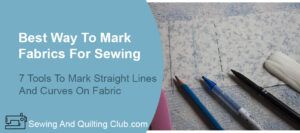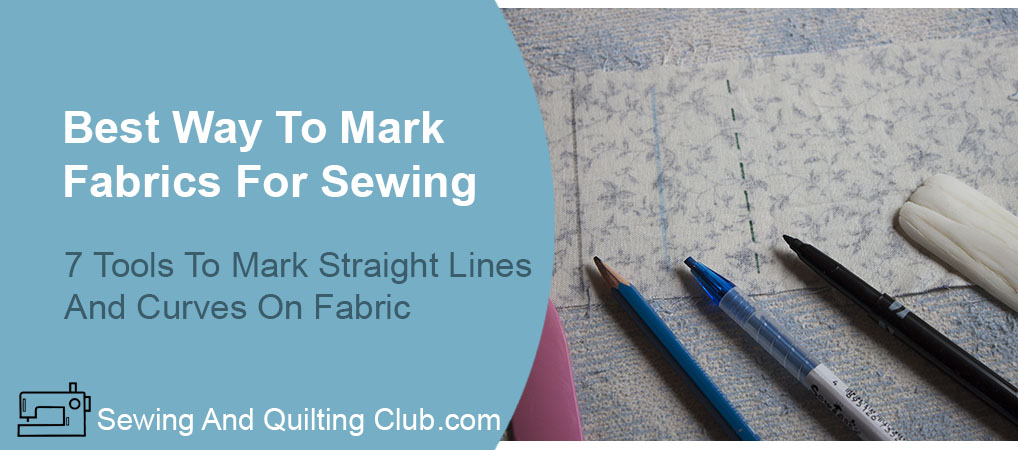As you work on your sewing and quilting projects, you might come many times for the need to trace and make some marks on a fabric, getting the best tool to help you to trace and mark a fabric will help you to get the best results on your projects, today we’ll take a look to the Best Way To Mark Fabrics For Sewing and quilting.
Best Way To Mark Fabrics For Sewing
What is The Best Tool To Trace A Fabric?
Once you start sewing, you’ll be working a lot to have your fabric on your table to measure it and mark it to know how to cut it and to sew it to make your next project.
 Small and big projects need to be an accurate measure, and cut to get the best results, without a good tool to help you to make straight and curve lines on the fabric, you might have hard times when its ready to sew on with your sewing machine.
Small and big projects need to be an accurate measure, and cut to get the best results, without a good tool to help you to make straight and curve lines on the fabric, you might have hard times when its ready to sew on with your sewing machine.
Taking the time to use the best tool to make any line or mark on the fabric for your next project, will help you to get the best results from your work.
Can I Use A Regular Pencil To Mark A Fabric?
Using a regular pencil or even a pen to mark a fabric might not be a good idea as it might leave a permanent mark on the fabric.
Some regular pencils are made with gray lead and some of it is hard to wash away from the fabric, it’s a better idea to use the pencil or any other tool made to mark fabric.
When Marking Any Fabric, Always Make A Test.
Once you decide to use any marking tool on a fabric, it will be better to make a test on a small piece of the fabric you’ll be using on your project to know how this tool works, and if it will wash away without leaving any mark.
Water Soluble Pencil
1 – I love to make any mark on fabrics with a pencil, it can be sharpened and it will help you to leave a fine line to follow with your sewing machine as you work on a project.
You can find these water-soluble pencils in different colors, so you can work with light and dark fabrics. The lines made with these pencils are easy wash away with water.
You can use these water-soluble pencils on your sewing, quilting and embroidery projects.
Water Soluble or Disappearing Ink Pens and Markers
2 – You can find a few different brands that market their products to help you to trace and mark your fabrics while working on a project, the benefits of using one of these water-soluble or disappearing ink pen or marker is that it will help you to trace lines, dots, and any mark on your fabric, it will be precise and you can use any color to help you to see that mark on any fabric, light ink color for dark fabrics and blue or black ink on light fabrics.
Ink will disappear completely when you wash the fabric or with a light Bloch of water, or with a warm iron, or with some time.
Some markers have ink that will disappear fast and you won’t have enough time to work on your project, you will need to make the marks again on your project to help you to get the results on your sewing that you want to get.
Ceramic Lead Pens
3 – When you want to get accurate marks on your fabric while you work on a project, the ceramic lead pens will help you to get accurate marks. These marks will go away easily with water.
Taylor’s Chalk
4 – One of the most known way to make marks on any type of fabric by sewers and tailors is the taylor’s chalk, it can be found almost in any color and it will help you to make any mark on your fabric.
Easy to use, and it can be removed or brushed away easily, it won’t leave any unwanted mark on your fabric. It can break easily but small pieces can also be used to mark any fabric.
Tracing Paper and Tracing Wheel
5 – A tracing method used by dress makers and tailors for many years that has helped them to trace both sides of the fabric at the same time, easy method to use. Each tracing paper package comes with tracing paper with different colors, so you can use the bright ones on dark fabrics and blue and black tracing paper on light fabrics.
These tracing tools will help you to mark on your projects with ease, long straight lines, curves or any corner while tracing your pattern on a fabric.
You need to get used to work with tracing paper so you don’t make a mess on the fabric while you work on it, or even get all the carbon from the paper on your hands.
One con of this tracing method is marks made with it will not stay on the fabric for a long time and it might be hard for you to follow the lines or marks you did on the fabric.
Bar-Soap Slivers
6 – A well know tracing method for many sewers, easy to get as you might have a few bar-soap slivers at home, easy to use mostly on colored fabrics as it’s hard to find a bar-soap in dark colors, it might leave some marks after you use it on a sewing project, so it’s better to use this marking tool only on washable fabrics.
Hera Marker
7 – A hera marker is a piece of hard plastic, it will help you to mark any fabric with ease by leaving a crease on the fabric, and it won’t leave any mark on the fabric.
One of the best thing about using a hera marker is that it works great without the need to use any kind of ink to help you to mark a fabric for your sewing.
It’s the perfect tool to mark straight lines, curves or any line you want to mark on a project you’ll be sewing on.
Thread Basting
8 – One of the most tracing methods used by tailors is to mark any lines on a project with thread basting, use a good quality thread, so it doesn’t leave any color mark after you remove it.
This technique is one of the best way to mark any line on a sewing project, but it not commonly used as it takes time to get it done, but if you like to get professional results on your sewing projects, I highly recommend using this method, while working on the thread basting, make long stitches (1/4 or 3/8 inches) easy to remove after to work to get those seams sewn and won’t leave any mark on the fabric.
You can read also Best Sewing Machines For Beginners
Best Way To Mark Fabrics For Sewing – Closing Thoughts
 There are a few different tools to help you to make any line and mark on the fabric for your next projects, not all the tools work the same, but each tool will help you to get better results on your projects.
There are a few different tools to help you to make any line and mark on the fabric for your next projects, not all the tools work the same, but each tool will help you to get better results on your projects.
My tip would be as a new sewer or quilter, use each one of these marking tools until you find the one you like more to work with.
As you work hard on your projects, making accurate straight lines or marks on the fabric will help you to get better results on your sewing or quilting projects, most of these tools are not expensive and having one or two in your sewing tools box will be a good idea.
You might find that having two or three different marking tools in the sewing tools box will be better as you might work with different fabrics, one marking tool might work great with delicate fabrics and you might need different marking tools for thick fabrics or even when you work with leather or canva.
I hope this article helps you to find the marking tool you need for your next project, if you have found another good tool to mark fabrics, share it on a comment, I would love to read about it.
Wishing you the best on your sewing and quilting projects!


Well lets just say I know very little about sewing and couldnt believe it when you listed ten different ways to mark fabric. Now if you ask my wife (like I did) then you will get a different answer.
Like many men and women but I believe women they are mostly self taught. I showed her this article and she got right into it explaining things to me. She felt great because she was in her element.
Thank you for writing a great article. It goes to prove in my case I can learn something new even on a path I never thought I would be on.
I wish I found out about this sooner, because I always have been using regular pencils to mark my fabrics for sewing. As you mention, those don’t always come out of the fabric when you wash them afterward. I think I am going to buy one of those water-soluble or disappearing ink pens for sure in the future! So thanks a lot for this information!
kind regards,
Lizzy